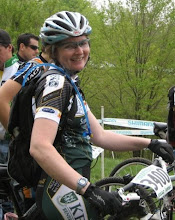A common trait of intermediate skiers is whole body rotation - also known as doing too much work. The skier may turn the whole body as a unit, so that the torso is always square to the skis. Or, they might generate rotation with upper body force - so that the shoulders turn more than the feet.
There are lots of ski instructor drills to develop more effective movements - some of these drills focus on stabilizing the upper body - hold a tray, hold the poles flat, etc. I often find that its more successful to help skiers learn to steer with rotary movements of the feet and legs independent of the upper body - once these skills are developed, upper body stability can be enhanced afterward.
When we want to help develop independent leg steering, don't be afraid to go back to the basics - many of the exercises I use are similar to those in most beginner progressions. Then, build the progression or lesson around what the student is capable of and their success (or lack there of).
Static exercises to develop rotary movements of the leg:
Do these on a flat surface for maximum success
No resistance
Coaching points
Once you've built the sensation and movements, incorporate them into sliding exercises that promote leg rotation.
Sliding exercises to develop leg rotation
Basic sliding exercises and drills
I'm giving these their own category because they will help develop rotary skills and I've used them successfully, but it can be harder to directly coach rotary and the sensations of leg rotation with these.
There are lots of ski instructor drills to develop more effective movements - some of these drills focus on stabilizing the upper body - hold a tray, hold the poles flat, etc. I often find that its more successful to help skiers learn to steer with rotary movements of the feet and legs independent of the upper body - once these skills are developed, upper body stability can be enhanced afterward.
When we want to help develop independent leg steering, don't be afraid to go back to the basics - many of the exercises I use are similar to those in most beginner progressions. Then, build the progression or lesson around what the student is capable of and their success (or lack there of).
Static exercises to develop rotary movements of the leg:
Do these on a flat surface for maximum success
No resistance
- Pick up ski, point the knee
- In boots - pick up foot, point the knee
- Walk in a circle or figure 8
- Walk feet in a figure 8 while upper body remains static
- Boot bowties in the snow
- Ski bowties on a flat surface
- Shuffled figure 8s in boots
- Half moons and inside-out half moons
- Laying on the back - have student lay in the snow, one leg in the air, knee bent about 90 degrees. Using both hands, put one beside the inside of the toe, one beside the outside of the heel. Have them press against your hands. Switch sides of the boot and then feet. Try this with a friend before using it in a lesson.
Coaching points
- For many of these static exercises, we want to develop sensations with the pivot point under the center of the foot. Skiers will often initially pivot around the heel or toe.
- When doing these, remember that for the purposes of leg rotation, the hip is part of the upper body and remains mostly stable.
Once you've built the sensation and movements, incorporate them into sliding exercises that promote leg rotation.
Sliding exercises to develop leg rotation
Basic sliding exercises and drills
- Sideslips
- Pivot slips
- Hockey stops or hockey stop garlands
- Shuffling while turning
- Wedge turns
- Short radius turns
- Short radius hop turns
- Hop to shapes
I'm giving these their own category because they will help develop rotary skills and I've used them successfully, but it can be harder to directly coach rotary and the sensations of leg rotation with these.
- 1000 steps
- Cowboy turns
- Javelin turns
- Tuck turns

Comments
Post a Comment